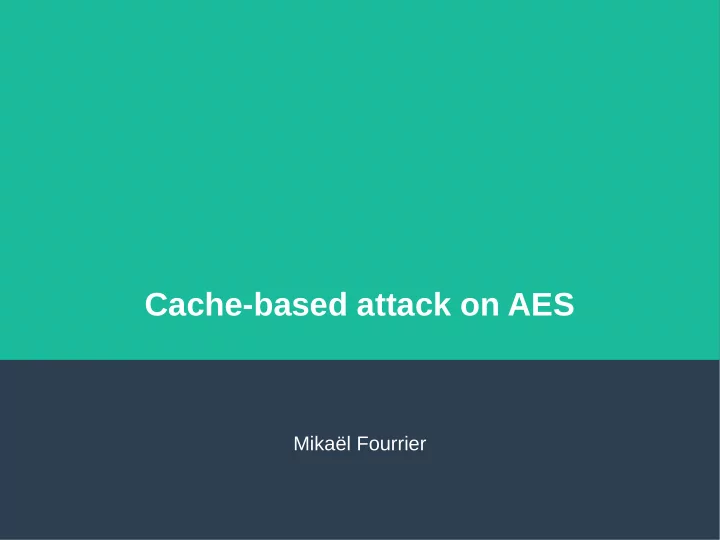

Cache-based attack on AES Mikaël Fourrier
Contribution of this paper ● Get the secret key from AES in 3s + 3min ● Very weak assumptions ● No known plaintext needed ● No special rights needed, only to be able to spawn and control threads 2
Side-channel attack ● Goal: attack the implementation instead of brute force or theoretical weaknesses – Timing attacks – Power-monitoring attacks – Electromagnetic attack – Acoustic cryptanalysis 3
CPU Cache ● The CPU is way faster than the RAM, so we add caches so that we don't have to interact with the RAM – The caches are divided in blocks (64-128 bytes) – L1 ~10kb – L2 ~1M – L2 14x slower than L1 – RAM 20x slower than L2, 200x slower than L1 4
AES 5
AES implementation ● Exploit redundancy in the matrix multiplications to speedup the calculation ● Massive use of precomputed tables → If we know which entry is use when, we can deduce the private key → Each round we get a probability that a byte sequence is part of the key 6
Main idea 1) Fill L1 with known data 2) Let the target execute one table load (will be a miss) 3) Detect which cache line has been changed 4) Deduce which part of the table has been loaded 5) Repeat! 7
Completely fair scheduler ● Linux process scheduler ● Goal: as with n processes executing on n processors at 1/n the speed. → Execute first the process which had less execution time 8
The attack ● DoS on CFS: hundreds of threads + one dummy thread 9
The attack - 2 ● Read a big array, if response time above a threshold → cache miss → the target process used this cache line 10
Neural networks ● One neuron has multiple inputs and one output ● Each input has an associated weight ● The networks learns by changing the weights 11
Post-processing ● Use of two neural networks: – Noise reduction (right) – Estimation on the number of memory access at t 12
Results ● 250 threads, 100 encryptions – 10ms → 2.8s ● Noise reduction: 21s, normal process ● Preparing key search by constructing a probability table: 63s ● Key search: 30-300s → 3 minutes to find the key → 60kB to transfer for post-processing 13
Countermeasures (general) ● Don't use the cache – Not possible in real life ● Don't let process access high-res timers – A lot of legitimate apps use it ● Cache preloading by the OS ● Mark table as uncachable ● Limit the minimum time between context switch 14
Contermeasures (AES) ● Use more efficient instructions to reduce table size ● Use hardware-supported encryption (Intel AES-NI) 15
References ● Paper: https://eprint.iacr.org/2010/594.pdf ● Wikipedia: https://en.wikipedia.org/wiki/Artificial_neural _network 16
Recommend
More recommend